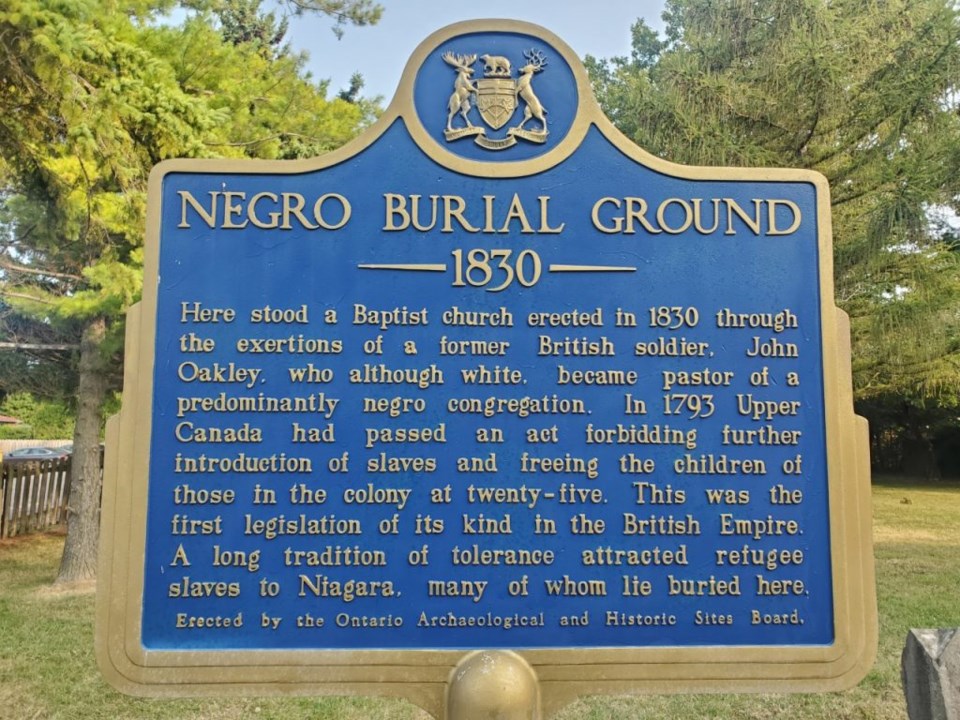
James Russell, a Toronto journalist-turned-film producer, is hoping to identify the people who are buried in the Negro Burial Ground by hiring a company that specializes in using ground penetrating radar for that purpose.
He estimates it will cost about $2,000, probably take about three hours, and he is willing to pay for the service himself, he told councillors at a Monday night planning meeting.
The real hard work will come after that.
Russell is expecting about 14 graves will be discovered — that information is from Natasha Henry, president of the Ontario Black History Society — and he hopes to mark them temporarily, perhaps with a small Canadian flag, and outline them with grass-friendly, non-toxic spray paint
And that, as a result of further research, more permanent markers will be designed, to be installed at some future date. “Given the wealth of glass, metal, and ceramic artists living in Niagara-on-the-Lake, I would ask the town to
perhaps launch a design competition for permanent markers,” he suggested.
“It breaks my heart to see the Negro Burial Ground disrespected,” he told The Local.
“I thought I should do something about it. The dead deserve more respect.”

On the site now is a historic plaque marking a grassy area on Mississauga Street that says: “Here stood a Baptist church erected in 1830 through the exertions of a former British soldier. John Oakley, who although white, became pastor of a predominantly negro congregation. In 1793 Upper Canada had passed an act forbidding further introduction of slaves and freeing the children of those in the colony at twenty-five. This was the first legislation of its kind in the British Empire. A long tradition of tolerance attracted refugee slaves to Niagara, many of whom lie buried here.”
Russell isn’t expecting to be able to put names to the graves where individuals are buried — he explains the ground-penetrating radar only detects anomalies, where the ground has been disturbed. But he does hope to come up with a list of the people who are buried there. That will be the hard part, and he’s planning on it taking a year or more to complete the necessary research. He’s hopeful, “although I’m not 100 per cent certain, that finding those names is possible.” He has spoken to Black history experts who believe it is, he added.
The small Baptist church was on the property until 1865, by which time members of the congregation had moved on, likely looking for work, and the wooden building probably just decomposed, he says. He’s hoping the Bapist Church Ontario headquarters will have the records preserved.
As for the graves, he has outlined three possibilities: either there were markers that were made of wood and decomposed; or they were made of stone, collapsed, and will be found lying under the ground — the best outcome he can hope for; or there were headstones that were stolen to be used as paving stones or in building foundations.
He would also like to produce a short film showing the progress of locating the graves with a five-minute monologue by a Black history expert about the history of Black folks in Niagara, he says.
Since incorporating MANKS Productions — named for the first letter of each of his children — he has produced several short films and now has four feature films on the go, he told The Local.
He first visited NOTL in 1985, when he was working on a story about water quality for The Toronto Star, and returned occasionally on work-related visits. He and his wife love NOTL, and come regularly, including a month-long stay they enjoyed in October at a short-term rental across from the Voices of Freedom Park. “That’s the longest time we’ve ever spent there,” he says, “and we’re really looking forward to coming back in September, and staying there again.”
Russell is really hoping for a successful outcome for the sake of descendants of the people whose graves he hopes to locate.
“Their ancestors are still around, and they would love to know their relatives are safe and where to find them, and to know they can visit them.”
He knows he has his work cut out for him — he’s a journalist and film maker, different skill sets than the kind of research he’s anticipating, he says.
But he’s expecting some help, from Kevin Turcotte, the town’s director of parks and recreation, and from Sarah Kaufmann, the NOTL Museum’s managing director and curator. They have already been helpful, he says, “and both will be great resources.”
“I don’t know how this is going to go,” he told The Local, “but locating the graves and giving them temporary markers is a place to start.”
Russell finished his presentation Monday with a quote from Mary Ann Evans, a Victorian novelist, poet and journalist, who said, “Our dead are never dead to us, until we have forgotten them,” and a plea for councillors. “I’m hoping the town will not forget the 14 Canadians in the Negro Burial Ground.”